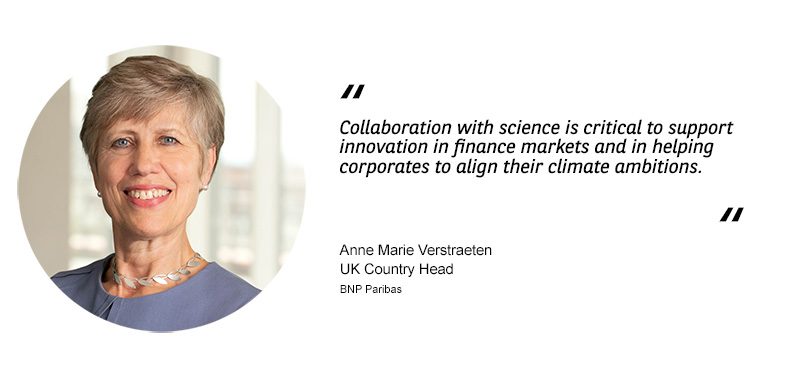November has been a landmark month
for green finance, with several groundbreaking announcements made at the Green
Horizon Summit in the UK, kicking off the finance industry’s journey towards
COP26. Mark Carney, UN Special Envoy for Climate Action and Finance, launched
the private finance strategy for COP26 at the event, stating: “Achieving the net zero will require a
whole economy transition, involving every company, bank, insurer and investor,
and creating the greatest commercial opportunity of our time.”
The City of London Corporation, the Green Finance
Institute and the World Economic Forum hosted the conference, which convened
experts from across the industry and policy landscape. These included ECB
President Christine Lagarde, climate expert Christiana Figueres, His Royal
Highness the Prince of Wales, BNP Paribas CEO Jean-Laurent Bonnafé, BNP
Paribas UK Country Head Anne Marie Verstraeten and other executives from
finance and beyond.
In his address at the Green Horizon Summit, Carney
outlined why finance will play a critical role in scaling up private sector
funding for innovation, which help companies to align themselves in the
direction of a net zero future. Addressing the importance of COP26, he commented:
“Our priority for COP26 is to
build this market in the transition on the pillars of comprehensive climate
reporting, better climate risk management and optimisation of returns.”
The opportunities of engaging on the transition towards a
low-carbon pathway are estimated at $26 trillion by 2030 vs the current
high-carbon pathway [1]. The
private finance strategy launched at the Green Horizon Summit centres on four key pillars:
- Reporting: improving the quantity, quality and comparability of climate-related disclosures by implementing a common framework built on the Taskforce on Climate-related Financial Disclosures (TCFD) recommendations.
- Risk management: ensuring that the financial sector can measure and manage climate-related financial risks.
- Returns: helping investors identify the opportunities in the transition to net zero and report how their own portfolios are aligned for the transition.
- Mobilisation: increasing private financial flows to emerging and developing economies by connecting available capital with investable projects and encouraging new market structures.
Throughout the Green Horizon Summit, corporates, policymakers, academics and innovators discussed the levers required to scale up climate action, covering the role of voluntary carbon markets, the importance of climate finance in emerging markets, how nature-based solutions could tackle the biodiversity crisis, and finally pathways towards net zero.
Several experts highlighted the importance of climate and nature-related disclosures. During the conference, Rishi Sunak, UK Chancellor of the Exchequer, announced that the UK would become the first country in the world to make Task Force on Climate-related Financial Disclosures (TCFD)-aligned disclosures mandatory across the economy by 2025.
BNP Paribas CEO Jean-Laurent Bonnafé delivered a key note at the event, addressing “the need for the finance industry to accelerate allocation of financial resources… and learn to build solutions with experts outside of the finance sector itself, to assemble solutions across both the private and public”. Bonnafé also mentioned the significance of disclosures, highlighting: “Along with standards, we must continue to strengthen disclosures. BNP Paribas has been a keen supporter of the TCFD and reports using this strong framework created under the leadership of Mark Carney. We know that next on the list is biodiversity.”

To meet the goals of the
Paris Agreement and keep the planet well below two degrees of warming, Bonnafé
outlined how BNP Paribas created the Paris Agreement Capital Transition
Assessment (PACTA). This was developed in coalition with four other banks,
and in collaboration with the
2° Investing Initiative and UN Principles for Responsible Investment. PACTA is
an open source methodology, which is now used by 20 banks to drive their
corporate loan book to align with various climate scenarios. It covers the
majority of high-emitting greenhouse gas sectors including utilities,
automakers, oil, gas and power generation.
The UK is hosting COP26 and is
also targeting reaching net zero by 2050. In this context, Anne Marie
Verstraeten, BNP Paribas UK Country Head, was a panellist on a ‘pathways to
drive the transition’ panel. The panel was moderated by Lord Turner, Chair of
the Energy Transitions Commission, and featured executives from Shell, Ninety
One and ACWA Power. In a discussion addressing the role of finance in
decarbonising energy-intensive industries, Verstraeten emphasised that “we are firmly convinced that collaboration
with science is critical to support innovation in finance markets and in
helping corporates to align their climate ambitions”.
In recent years, sustainable
finance innovation has included the development of science-based
targets in the bank’s lending facilities, as well as incentive mechanisms that
integrate sustainability into the financing system. A recent example was a
£2.5bn sustainability-linked loan (SLL) completed
by UK supermarket Tesco, which embeds scope 1
and 2 CO2 emissions reduction targets to support Tesco’s
decarbonisation strategy.
The key performance indicator (KPI)-linked
mechanism in SLLs has been applied to the bond market through the creation of
sustainability-linked bonds, which embed transparent and credible targets into
bond coupon mechanisms. Recently CHANEL – a luxury company – pioneered
a €600m sustainability-linked bond tied
to climate targets, which also included a reduction in scope 1 and 2 CO2
emissions, and shifting to 100% renewable energy in business operations by
2025.
|
BNP Paribas engagement on energy transition
|
[1] Source: Building a private finance system for net zero: Priorities for private finance for COP26

